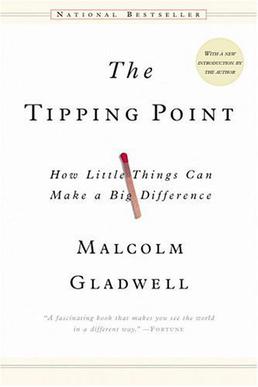"The Tipping Point" Review
 The Tipping Point is a book written by Malcolm Gladwell and it was originally published in 2000.
The Tipping Point is a book written by Malcolm Gladwell and it was originally published in 2000.
The whole idea of the book, and I say the word “idea” on purpose, is that many people come up with great ideas, but once an idea truly reaches its Tipping Point, it spreads faster than you could ever imagine. “The Tipping Point” is written with the perspective that there are three main teachings when it comes to ideas. The first one is that once the idea reaches its “tipping point”, it spreads fast. The next is that there are three different genres of people that help the idea reach that point. The last is that, without the idea being memorable, the idea will never truly reach the tip.
Gladwell describes the first teaching like a wildfire. Once it catches fire (or reaches the tipping point), the idea spreads uncontrollably. In today’s society, there are a lot of ideas or companies that experience the wildfire effect. Let’s take snapchat, for example. When it first began, there was a minimal amount of success. But once it hit its tipping point, it seems like everyone had to have one. Even some parents were getting in on the action and downloading the app. The company Gladwell uses to describe this concept is the resurgence of the Hush Puppies shoes in the early 1990s. I couldn’t necessarily relate to it, so I put my own spin on the teaching.
The second teaching of Gladwell from “The Tipping Point” is that there are three genres of people who help the idea reach its tipping point. Gladwell calls them the “Law of the Few: Connectors, Mavens, and Salesmen” and goes into great detail when describing each one. The connectors are individuals who are masters at networking. They engage relationships and cross-contaminate an idea until it tips. The Mavens are great influencers as they have enough information to help people make informed decisions. The Salesmen, which should be pretty self-explanatory, are the persuasive people full of charisma who convince others to buy into the idea. These are the three keys to get the idea to reach its tipping point. Gladwell conveys that if you want to be successful, you must have all three.
The stickiness factor is how memorable an idea is and how much it influences future behavior. If you want your idea to tip, you must have the stickiness factor. According to Gladwell, Sesame Street was the first advocate for the stickiness factor, claiming how they’ve successfully reinvented children’s TV over the past 40 years. Instead of staying on the same path as other children’s TV stations, Sesame Street looked into the cognitive ability of a toddler and actually helped toddlers improve their literacy in just a couple of decades.
“The Tipping Point” describe show an idea can spread like wildfire and how having three simple genres of people can help the idea reach that wildfire stage. It shows how an idea, if it has the right stickiness factor, can influence the behavior and the future of our next generation. I would highly recommend this book for anybody who is struggling to find a way to become successful or for someone who needs a kick in the right direction.

Comments
Post a Comment